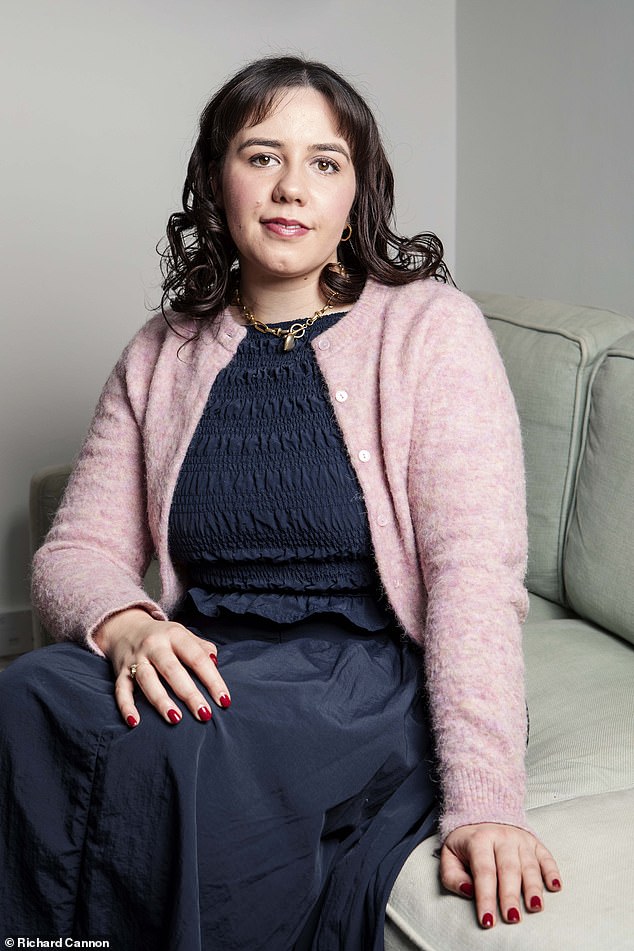For many women, that time of the month is simply that: a specific number of days when they experience – to varying degrees – discomfort, inconvenience and pain. But Robyn Cowie’s periods at times make it difficult even to go for a walk in the park.
‘I get agonising sharp pains around my womb and ovaries just before and during my period, as well as mind-numbing fatigue and often terrible sickness,’ says Robyn, 26, who works in marketing.
‘The pain is so extreme that it can make it impossible to work. I’ve also ruined countless outfits and had some very embarrassing situations,’ she says.
‘At a recent dinner party, I knew as I got up that I’d bled badly and I had to make my excuses and left.’
What’s more she says, ‘losing so much blood can make me faint’.
‘On one occasion a few years ago, I blacked out, smashed my face and fractured my cheekbone, which was absolutely horrible. It is just horrendous,’ she says, ‘I wouldn’t wish this condition on anyone.’
The condition she is referring to is adenomyosis, which affects one in ten women in the UK, causing painful and exceptionally heavy periods which can continue for days.

Robyn Cowie suffers from adenomyosis, which affects one in ten women in the UK, causing painful and exceptionally heavy periods which can continue for days
It can also impact fertility, while those sufferers who do become pregnant have an increased risk of miscarriage and problems such as pre-eclampsia and pre-term delivery.
Yet despite how common it is, awareness of the condition remains low and many women wait years for a diagnosis – their pain and heavy bleeding too often dismissed as ‘normal’.
Adenomyosis is similar to endometriosis, where tissue that lines the womb grows elsewhere in the pelvis.
With adenomyosis, however, the cells that make up the lining of the womb ‘bury deep into the muscular wall of the womb itself’, explains Dr Shirin Lakhani, a GP who specialises in women’s health.
These cells respond to hormonal fluctuations and thicken, break down and bleed every month, just like the tissue that lines the womb does. However, with adenomyosis this can cause agonising pain and bloating, as the tissue and blood that is shed is trapped deep within the muscular wall of the womb.
The womb may become so enlarged in the run up to a period that it feels heavy, and women may become uncomfortably bloated – a symptom sometimes referred to as adenomyosis belly.
Some also experience pain during sex or opening their bowels.
While not life-threatening it can be life-altering, as the symptoms can have such wide-reaching effects – not only because of extreme pain and blood loss.
While most commonly diagnosed in women between the ages of 30 and 50, it can strike at any age and can impact women’s educational achievements (the pain and bleeding can be distracting during exams) and work prospects.
Robyn’s periods are so intense that she left a much-loved job to change to a different role simply because she can now work at home – but she finds even meeting friends for a drink difficult at times.
‘At 26 I just want to go out and have a good time,’ she says.
Because it affects the womb lining, adenomyosis can potentially make it harder for an embryo to implant in the womb.
What’s more, there is no cure for the condition – and in the worst cases, it may lead to needing a hysterectomy (surgery to remove the womb).
‘I was devastated when I read that it was incurable,’ says Robyn, who was diagnosed two years ago.
‘I thought “is this how it’s going to be – all this pain unless I have a hysterectomy”? Given I’d love to have children one day, it’s horrible to have that hanging over you.
‘It also seems such a brutal and extreme way to treat a condition in this day of modern medicine.’
The exact cause of adenomyosis isn’t known, though genetics and malfunction of the immune system – as well as hormonal changes – may play a part.
Risk factors include having had multiple pregnancies or having had a caesarean – the theory is that cutting into the area might release endometrial tissue into the muscles of the womb.
Yet even though it affects many women, because of lack of awareness, it can go undiagnosed for years.
BBC TV presenter Naga Munchetty, 50, who has suffered with the condition since she was a teenager, has previously said she was told her symptoms were ‘normal’ and to ‘suck it up’ by doctors, during the 35 years she sought help.
A report last year by the Women and Equalities Committee – a parliamentary select committee – said women experiencing painful reproductive health conditions such as endometriosis, adenomyosis and heavy menstrual bleeding frequently find their symptoms ‘normalised’ and their ‘pain dismissed’ when seeking help.

Naga Munchetty, 50, who has suffered with the condition since she was a teenager, has previously said she was told her symptoms were ‘normal’ and to ‘suck it up’ by doctors
Robyn, whose periods began when she was ten, had excessive pain and bleeding from the age of 14, but repeated visits to her GP resulted in very little clarity.
She recalls: ‘Doctors told me that it was just one of those things, though on one occasion – incredibly, I was only 15 – they were sure I was having a miscarriage, even though I hadn’t been sexually active. It was baffling and frustrating.’
Another problem, says Narendra Pisal, a consultant gynaecologist at the London Gynaecology clinic, is that some women delay seeking help.
‘A large proportion of women have heavy and painful periods and accept the symptoms as ‘normal for me’,’ she says.
‘Women don’t often know how heavy or painful their periods are supposed to be. When they do seek medical attention, often the doctors would start medical treatment to control symptoms – specifically to stop the excessive bleeding – but they may not then get the scan they need to actually pick up the condition,’ she explains. ‘That may then lead to delays in them getting the right treatment.’
‘Many clinicians received minimal training about adenomyosis during their medical education, with the condition often mentioned as a footnote to endometriosis rather than a distinct entity requiring specific management approaches,’ adds Denis Tsepov, a consultant gynaecologist and laparoscopic surgeon at the Princess Grace Hospital in London.
The condition is usually diagnosed with a transvaginal scan, where a small probe is inserted into the vagina to inspect the womb, or with an external scan (such as an MRI).
Even then, as Mr Tsepov explains: ‘These scans are very operator-dependent in terms of quality and require advanced level of experience.’
Treatment depends on a woman’s age and circumstance and may include the Mirena coil, which releases a dose of the hormone progestin – a synthetic form of the hormone progesterone – directly into the womb, which can help the reduce the build-up of tissue in the lining and significantly reduce bleeding.
Some specialist centres now offer surgical options, such as adenomyomectomy – removing the affected tissue while preserving the womb, in a keyhole procedure.
‘However, there is no convincing evidence to date of these options being fully efficient in achieving sustained pain relief in adenomyosis patients,’ says Mr Tsepov.
Women who find no relief with other options may be offered a hysterectomy.
Robyn was sent for scans by her GP, but was told mistakenly that she had polycystic ovary syndrome (a hormonal condition that causes irregular periods). However, in 2023 she took her scans to a private gynaecologist who diagnosed adenomyosis.
‘I had no idea what this was, and I was just so scared and shocked,’ she says. ‘When I looked on the NHS website there was barely any information.’
Robyn was given the combined contraceptive pill Rigevidon, which helps thin the womb lining and diminish blood flow, as well as mefenamic acid, a non-steroidal anti-inflammatory drug to reduce pain and inflammation.
Although this helped to dampen down the symptoms, by the age of 22, they returned with a vengeance.
‘I would be bleeding constantly and was always terrified of having an accident,’ she says.
‘Sitting at a desk during those episodes was impossible – I’d literally be flooded while the loss of blood made me so faint. If I got caught off-guard and my clothes were soiled, I’d have to run out and buy something to wear or go home. Thankfully work has been understanding, and I now work mainly from home.’
Robyn’s doctors are now trialling different contraceptives to stop her periods.
She began a course of Noriday, a progestogen-only oral contraceptive pill – which restricts blood flow and growth of tissue – which has helped.
She says: ‘I finally have an understanding gynaecologist who wants to make me as happy and comfortable as possible. I’ve also adapted my lifestyle. I mainly work from home and just go to meetings or events when I’m needed. I’ve also cut down my working week to four days.
‘But it’s still a battle – not least as someone in her 20s who is dating as it is a hard condition to explain. But I refuse to let adenomyosis ruin my life. We just need doctors to take women like me seriously, give thought to what causes heavy periods and so prevent years of needless suffering.’







